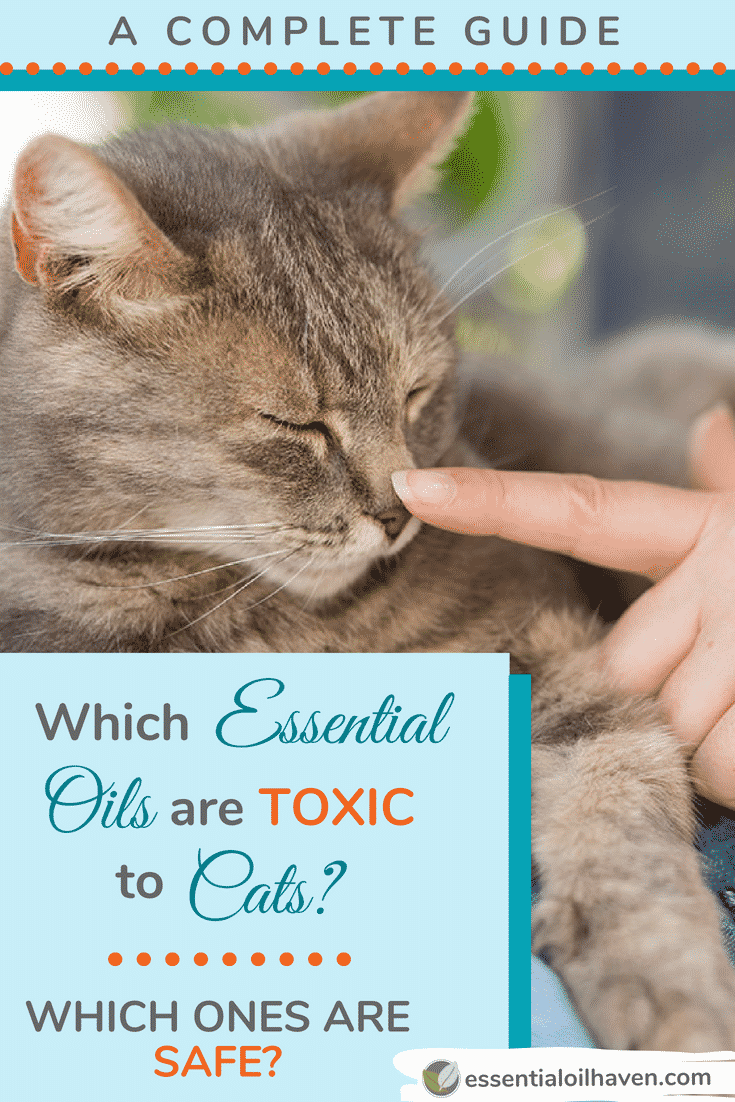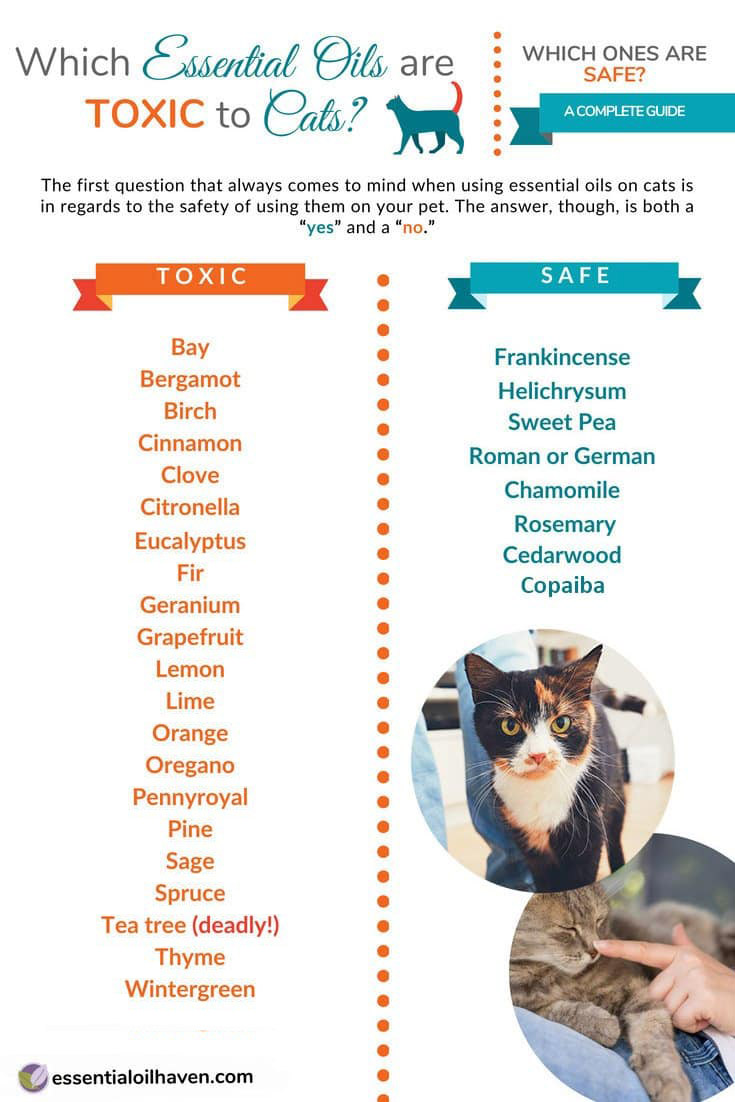 Your cat’s sense of smell is indeed exceptional. Cats have stronger senses than humans and their nose is way more sensitive than ours, so it’s definitely possible that scents you might find calming and wonderful, can be extremely strong and overwhelming for your cat.
Your cat’s sense of smell is indeed exceptional. Cats have stronger senses than humans and their nose is way more sensitive than ours, so it’s definitely possible that scents you might find calming and wonderful, can be extremely strong and overwhelming for your cat.
If you have a domestic pet cat and you want to use essential oils, there are several things to keep in mind to ensure the safety of your pet.
This article is a complete guide for cat owners to understand how to ensure the safety of their pets because essential oils are becoming an invaluable commodity in our homes. A variety of ways you maybe already are incorporating essential oils into your daily life, include herbal remedies, aromatherapy, liquid potpourri, body care products, and natural home cleaning products.
This post contains affiliate links, which means if you make a purchase through these links, I may receive a small commission at no extra cost to you. Read my full disclosure policy here.
Knowing the basics about the potential effects of essential oils to your cat is vital. When it boils down to the questions of the toxicity of these oils to your cats, the bottom line assures that it all depends on the quality and specific chemical elements of the oil being used.
Is it Safe to Use Oils on Cats?
The first question that always comes to mind when using essential oils on cats is in regards to the safety of using them on your pet. The answer, though, is both a “yes” and a “no.”
While it is true that there are some essential oils that cats could tolerate and in fact help fight several health conditions, some oils likewise affect cats by showing signs of toxicity, leading you to the veterinarian most of the time. Cats are wired very differently from humans so what may be safe for you may impact your cat in a totally different way.
Nevertheless, science has provided research on the potential benefits of several essential oils on our cats if used with caution and in adequate dosages.
I have to distinguish here, that there is a difference between using essential oils topically on your cat, vs. diffusing them around your home for your own well-being and/or that of your feline friend.
Essential oils are much more potent when applied directly to the skin (yours or that of your cat). Essential oils diffused in a room that your cat may frequent, is much less of a safety hazard than trying to treat your cat with oils by applying them to his or her body. Special consideration do go to using essential oils on your own body by way of DIY essential oil body care products, lotions or creams; since your pet may have physical contact with you and potentially lick the oil contents off your skin.
How to Use Essential Oils around Your Cat (Quick Guide)
- Start slowly. Don’t diffuse heavily to begin with, to air on the cautious side.
- Every pet is different. Observe your feline friend closely as you introduce essential oils. Look for behavior changes or other oddities.
- Avoid eyes, nose, mouth and paws. Be sure to avoid those sensitive areas on your domestic cat. Store bottles out of reach or behind cupboards to ensure your cat can’t accidentally chew on them.
- Wash your hands. Never pet your cat after having applied essential oils to yourself.
- Know your oils. Work without oils high in phenols (such as Oregano or Thyme).
- Don’t use Citrus oils. Cats normally avoid citrus oils.
- Do NOT use Tea Tree oil. (Melaleuca alternifolia). It is deadly to cats.
Essential Oils that are Toxic to Cats
Scanning through testimonies and research studies, science elaborates on the possible effects of several essential oils to the feline species. The internet is bombarded by articles saying how their cats are killed by essential oils but clarifications are yet to be made. There is always further information to be examined before coming to a conclusion. And, every pet and household is different. No wonder people often are confused regarding this matter.
Most important to know, is, that essential oils are highly concentrated and contain phenols and other phenolic substances that are considered toxic to cats. If your cats ingest these substances, their intestines and liver don’t have the necessary enzymes capable of eliminating, absorbing, or even digesting the oils leading to various health complications in the animal.
Essential Oils to Avoid
|
|
|
This is not a comprehensive list
Toxicity and Danger Symptoms of Essential Oils to Cats
What are the symptoms that would indicate that essential oils have poisoned your cat? The symptoms of cat poisoning through an essential oil depends on the kind of oil administered around the cat. However, in general and summarized, these symptoms include¹:
- Aches and pains during breathing
- Coughing, wheezing, fast breathing, and gasping for breath
- Salivating or drooling
- Low heart rate
- Liver failure
- Shivering and shaking
- Low body temperature
- Nausea or vomiting
- Inability to walk or ataxia
Consult your veterinary doctor immediately if you notice any of these signs; they are suggestive of essential oil poisoning.
Which Oils Are Safe To Use Around Cats?

Essential Oils You Can Use Around Cats:
- Effective as antiseptic, disinfectant, and anti-inflammatory, Frankincense oil may also assist in addressing the cat’s digestive problems.
- Helichrysum oil detoxifies and contains properties which are antibiotic and antifungal.
- To reduce stress and depression in your cats, which is surprisingly common to the feline species, Clary Sage oil can shift your cat’s hormones into a balance and even boost its mood and emotions.
- Help your shy cat develop more courage with Sweet Pea essential oil.
- Use Roman or German Chamomile for anti-inflammatory help.
- A few effective flea repellents are Rosemary oil and Cedarwood oil, if diluted or diffused properly.
- For balancing, calming and relaxing your cat, Lavender or Valerian are ok to use.
Using Oils on Cats: Dilution Rates
Even natural and 100% pure essential oils need to be diluted before using them on felines.
You can dilute your oils using pure vegetable oil, make sure this is high grade, as recommended by Dr. Mary Hess, DVM. Dilute at a ratio of 50:1 which means you dilute a drop of your essential oil to 50 drops of dilution oil. Use just a drop of this diluted oil and apply to your cat from ear to tail.
Another way to dilute your oils is to add 3-5 drops of essential oil in a spray bottle filled with water (can be halfway or less), shake the sprayer then finally, spray gently on your cat.
The most common technique to receive the benefits of aromatherapy on cats though, is through diffusing essential oils through a diffuser. Over time, while humans have enjoyed the beneficial results of oils in improving overall health, people also started using them on animals to see if they also create wonderful impacts on animals. Using essential oils through the diffusion method has been one effective way to do so.
It is very important that you only use therapeutic grade essential oils as many of the problems arise when you buy products marketed with high prices but low quality and use them on your cat.
Things to be Wary Of When Using Oils on Cats
Common scenarios reveal essential oils to cause toxicity in cats, and that is something that you should watch out for. Cats may show signs through changing their habits in sleeping and eating; behavior changes such as tiredness, and lack of energy; digestive problems such as constipation, diarrhea or vomiting; and light-headedness.
In conclusion, essential oils generate various effects on your pet, but the general conception is that, as long as you only choose oils acceptable to cats, and these oils are kept in concentrations and levels which are low to moderate only, chances are your cat will be safe from any possibility of toxicity.
Make sure that you store essential oils properly and unreachable by your cat. If your pet cat has a serious medical problem and you deem essential oils to be useful, it is necessary for you to check with a veterinarian first as they may know better and may even recommend professionally blended oils that you can use.
How To Diffuse Essential Oils In Your Home
There are few different types of diffusers available on the market, all of which release essential oils into the air in a different way.
- Ultrasonic diffusers: These function using electricity, water and the unit. The power produces vibrations of an ultrasonic disk centered at the bottom inside the diffuser unit’s water tank. The ultrasonic vibration creates a cold mist air, and if the water has been mixed with essential oils, the diffuser releases the scents and compounds your essential oil into the air quickly.
- Nebulizing diffusers: Function without water, 100% essential oil is placed into the diffuser and dispersed into the air when in use.
- Passive diffusers: Such as reed diffusers or essential oil jewelry. Passive diffusers function using simple evaporation, thereby causing the fragrance to be emitted accordingly.
- Heat diffusers: Examples are candle burners or tabletop warmers. Heat diffusers are not generally recommended for aromatherapy because the heat alters the therapeutic properties of essential oils. None the less, people do use them around their homes and should use caution with them if their home is home to a cat.
Resources
- ¹ Pet Poison Helpline
- AnimalEO.info
- Essential Oils for Cats: Uncommon Ways To Safely Use Cat Essential Oils With Natural Cat Remedies For Optimal Health – by Tonny Ford RN





Can I use a passive diffuser with Lavender in my room if Luna, my cat is in the room.
Thanks
Are there any essential oils that address ringworm and are safe for cats?
Can I use the essential oils-frankinsense, myrrh, and helichyrum(?) on my skin with my four cats?
Hi Angela, that’s really tough to answer as I wouldn’t want your cats to get ill. If any oil is on your skin, there is a chance that they can lick it, thus ingest it. And ingestion is a really really tough subject. So I’m going to say no.